|
1956 - Denham on TV.
Now the aerodrome was being run as a business. One event during 1956 was to raise the profile of Denham and lead to a number of rallies, meetings and shows to be held at the aerodrome over the next decade. With both flying club and maintenance facilities based on site, the aerodrome became more useful. The grass surface was cut once a year for hay by a local farmer and businessman, the photo below showing this work in progress. Interestingly, it seemed that each time the cricket groundsman cut and rolled the pitch, the perimeter got a little larger!
|
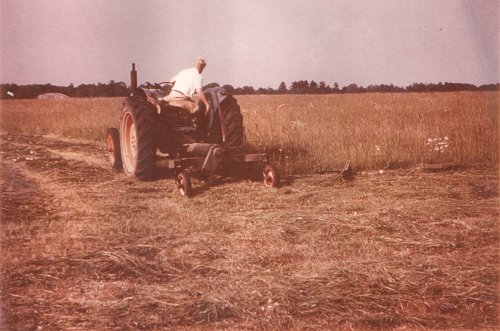
Denham Aerodrome in 1956 with the grass being cut. This often produced over 3,000 bales of cuttings.
|
One of the members of the Denham Flying Club, Jim Scarlett, was a former RAF airframe mechanic. He produced a local map of the airfield, in the style of a pirate treasure map. The map included 'Here be Tygers' and 'Here be Maggies' denoting the major types of aircraft on each side of the airfield, while the swimming pool was annotated with 'Here be tadpoles'! The distances and directions to nearby airfields were marked, as were roads and the local railway stations, although the British Rail logo showed the lion asleep off the wheel!
|
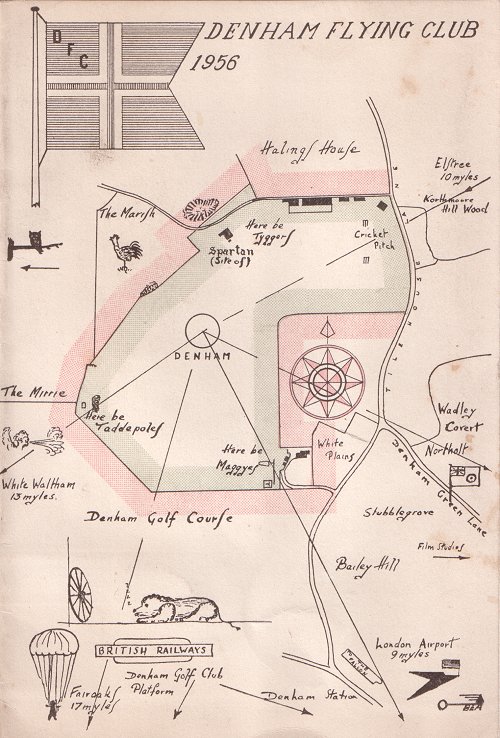
Jim Scarlett, a member of the Denham Flying Club, drew this imaginative treasure map rendition of the aerodrome in 1956.
|
The year started with an unfortunate accident. G-ACHP was an Avro 638 Club Cadet that had been re-engined with a Gipsy Major 1 and had been a regular visitor to Denham. It had been impressed into service as a trainer during the Second World War and then acquired post-war by the Vintage Aeroplane Club. Two of their members, Mr Jock Ogilvy and Mr G H Cullen were flying into Denham around midday on 1 January when they were caught in an unexpected squall. On making an approach to the aerodrome a gust caught them and the aircraft struck a tree. Both men escaped injury in the ensuing crash but the aircraft was written off.
|
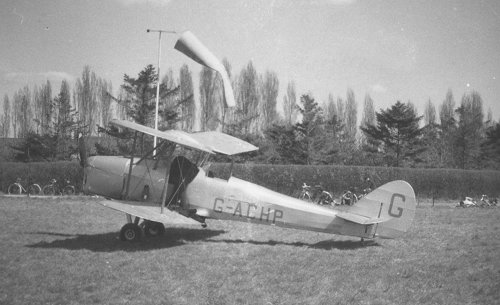
Above, Avro 638 Club Cadet G-ACHP seen visiting Denham in 1955, owned by the Vintage Aeroplane Club. On 1 January 1956, G-ACHP hit a tree on landing at Denham in a sudden squall, both pilots escaping without injury.
|
A new visitor appeared at this time. Ranald Porteous was the test pilot for Austers and his cousin lived in a charming house in the centre of Denham Village. Ranald had enjoyed a remarkable career, begining as a student at the de Havilland Technical College in Hatfield, where he had met many of the people who were to feature in his later life, including the founder of Chilton Aircraft and the designer of the Ding-Bat ultralight, a machine he was later to demonstrate at airshows. After joining the RAF Reserve he had been posted to Rhodesia as the head of the Empire Air Training Scheme there, a post he was to fill throughout the war. Prior to the war he had been the test pilot of the Chilton DW-1, an aircraft he returned to in 1947, setting the International 100km Class 1 Closed Circuit record in the aircraft that year. The little single seat racing aircraft had been designed by two ex-de Havilland Technical School students, Dalrymple and Ward, who had set up their own aircraft company to produce the design. Four were built by the company before the Second World War, and three more by private builders after the conflict. Powered by a modified motor car engine, a 32hp Carden Ford, the DW-1 was still capable of a maximum speed of 120 mph. Ranald was to race Chiltons and display Austers throughout the 1950s, the proximity of Denham to his cousin meaning that he became a regular visitor to the aerodrome.
|
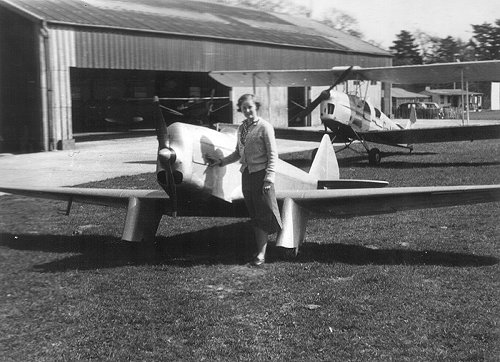
Jill Bickerton photographed with her father's Chilton DW-1.
|
Ranald had several contacts at the BBC and in June 1956 they decided to make a outside broadcast television programme about general aviation in Britain. Denham was chosen as the location for this and a transmission tower was erected on the south side of Hangar Road along with the attendant camera and control vehicles. Visiting aircraft came from all over the UK and just about every British light aircraft manufacturer was represented on the aerodrome.
|
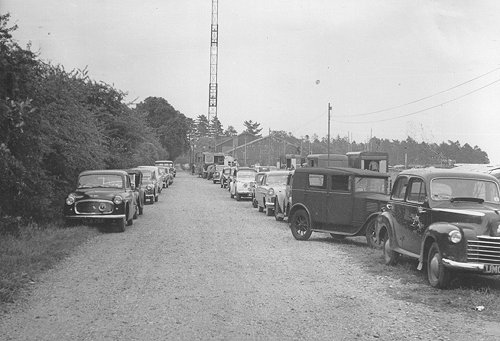 The BBC came to Denham in June to produce a live broadcast programme about general aviation in Britain, erecting a broadcast tower on Hangar Road. The BBC came to Denham in June to produce a live broadcast programme about general aviation in Britain, erecting a broadcast tower on Hangar Road.
|
|
 One of the people behind this event was test pilot Ranald Porteous, seen here taxying out in Auster J5R Alpine G-ANXC. One of the people behind this event was test pilot Ranald Porteous, seen here taxying out in Auster J5R Alpine G-ANXC.
|
|
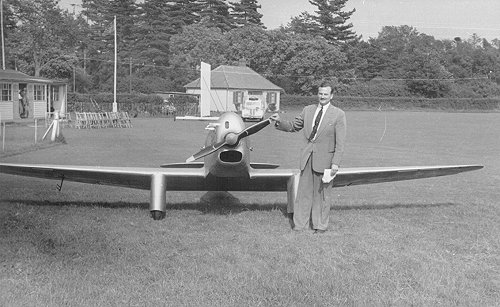 Ranald Porteous seen at Denham with the Chilton DW-1, an aircraft he delighted in racing and displaying. Ranald Porteous seen at Denham with the Chilton DW-1, an aircraft he delighted in racing and displaying.
|
The event included some rare visitors, including a Miles M.17 Monarch, a BA Swallow 2 and a Foster Wikner GM.1 Wicko. Interestingly, the last aircaft on that list, G-AFJB, is still flying today. Alongside the rarer aircraft were many types from Auster, de Havilland, Luton, Miles and Percival, as well as three Hunting Percival Piston Provosts from the London University Air Squadron, the LUAS maintaining its relationship with the aerodrome from before the Second World War.
|
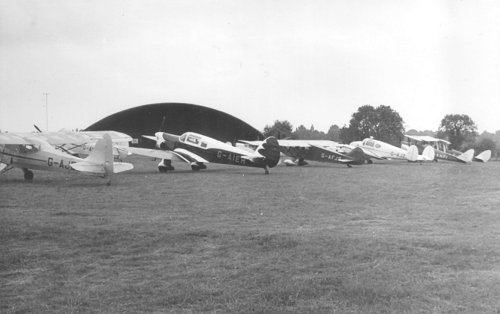 Many visitors were attracted by the BBC programme, representing most British light aircraft manufacturers. Here Auster, de Havilland, Miles and Percival are joined by a rare Foster Wikner GM.1 Wicko, G-AFJB, which is still flying today. Many visitors were attracted by the BBC programme, representing most British light aircraft manufacturers. Here Auster, de Havilland, Miles and Percival are joined by a rare Foster Wikner GM.1 Wicko, G-AFJB, which is still flying today.
|
|
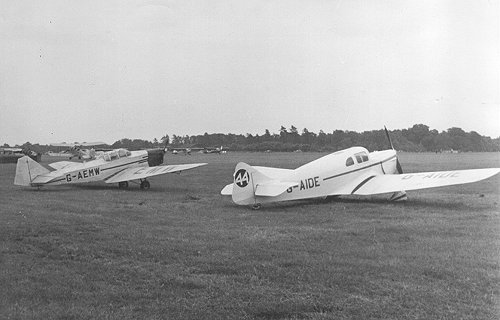 Two other rare visitors were BA Swallow 2 G-AEMW and Miles M.17 Monarch G-AIDE. Two other rare visitors were BA Swallow 2 G-AEMW and Miles M.17 Monarch G-AIDE.
|
In the top picture above, Percival Proctor G-AIER can be seen. This was painted in a unique black and white colour scheme and belonged to long time Denham resident Mike Dible. Mike was an engineer for the Sperry Gyroscope Company which produced many of the avionics and instruments used in aircraft around the world. A number of demonstrations were laid on for the BBC cameras, including a six man parachute team and a handicap air race. The programme was considered a great success and put the airfield firmly on the map.
|
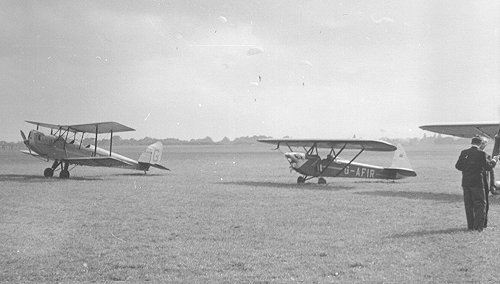
Demonstrations in front of the BBC team included a six man parachute team, seen here landing behind the Denham based Spartan Arrow and a visiting Luton LA4 Minor.
|
|
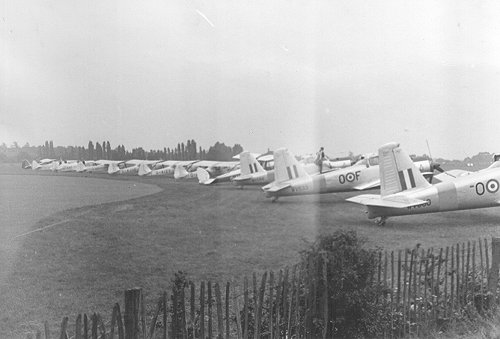
The RAF also flew into Denham for the BBC, three Hunting Percival Piston Provosts of the London University Air Squadron lined up here with aircraft from the home based flying clubs.
|
Unusually for the time, Denham had several women pilots working and training at the aerodrome. Janet Fergusson lived in Higher Denham with her mother and sister. She was a popular instructor, even teaching her own mother to fly. In the next chapter we will record something of the unique career of Yvonne Pope, who was to become the first woman Air Traffic Controller and then Captain on a jet, the BAC 1-11. One of Yvonne's students at Denham was Beatrice, Myles Bickerton's youngest daughter.
|

Mrs Fergusson and Beatrice Bickerton in a Magister, both student pilots in 1956.
|
The year was a busy one at the aerodrome, a condition that was to continue as will be related next.
|
|

